

Cloud Atlas Review (Film, 2012) Lana Wachowski, Tom Twyker, and Andy Wachowski have accomplished something very special in Cloud Atlas.

They discovered a clear and natural way to tell a metaphysical narrative of love, kindness, and actions echoing throughout all of time. Each scene in the six very different storylines is connected by an emotional or physical event that ties the core group of spirits together over centuries. The method becomes clear at the halfway point of the film, where explosions, falls, and acts of aggression rapidly echo throughout the flow of history.
Cloud Atlas is not breaking any new ground in theme or philosophy. It’s riffing on the same emotional core of films likes Babel and Extremely Loud & Incredibly Close. The innovation from the Wachowski siblings and Tom Twyker is essentially creating an anthology film that feels like a cohesive narrative without a framing device. The same core cast populates all the tales of Cloud Atlas. Within the film, it is a clear way to connect the stories. Cloud Atlas: Thoughts on Genre, Costuming, and Yellow Face (spoiler-free) Posted on October 27, 2012 Ultimate Genre Mashup: My elevator pitch for the Cloud Atlas would be: Moby Dick meets Howard’s End meets China Syndrome meets Waking Ned Divine meets Blade Runner meets Mad Max. The Wachowski sibs and probably had a much better pitch, because they were able to raise $100 million in independent funding.
But the point is that they pulled off a six-way genre mashup, with arcs that play off of each other on multiple levels and are tied together through its characters, themes, easter eggs, and metaphysical references: 1800s Melvillesque high seas drama Early 20th century British drama 1970s journalist/whistle-blower thriller 1990s comedic romp with an elderly cast Cyberpunk action set in a near future dystopia Post-apocalyptic survival This was a high-risk venture. Costuming Challenges. Cloud Atlas criticised for 'badly done yellowface'
The Cloud Atlas Conversation: Yellowface, Prejudice, and Artistic License. The shock of watching the Cloud Atlas trailer, and witnessing white actors portray Asian characters, is that there is no shock.
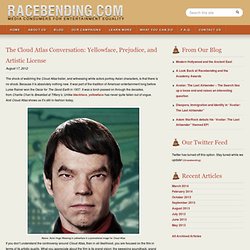
Because it is absolutely nothing new. It was part of the tradition of American entertainment long before Luise Rainer won the Oscar for The Good Earth in 1937. It was a torch passed on through the decades, from Charlie Chan to Breakfast at Tiffany’s. Unlike blackface, yellowface has never quite fallen out of vogue. Cloud Atlas Review: Yellowface And Orientalism. By Guest Contributor Jennifer; originally published at Mixed Race America This post is the second installment in a three-part review.
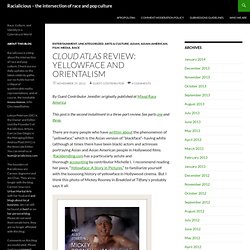
See parts one and three. There are many people who have written about the phenomenon of “yellowface,” which is the Asian version of “blackface”–having white (although at times there have been black) actors and actresses portraying Asian and Asian American people in Hollywood films. Racebending.com has a particularly astute and thorough accounting by contributor Michelle I.
I recommend reading her piece, “Yellowface: A Story in Pictures,” to familiarize yourself with the looooong history of yellowface in Hollywood cinema. Alden Habacon: Yellowface In 'Cloud Atlas' Continues Hollywood Tradition of Racism. As the big budget film adaptation of David Mitchell's novel Cloud Atlas opened in Canada and U.S. over the weekend, it joins the ranks as one of the most epic displays of "yellowface" in film in a decade.
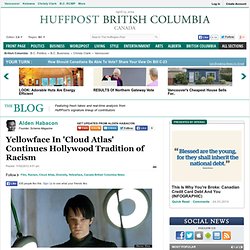
Directed by Tom Twyker and Lana and Andy Wachowski, the film's trailers, television ads and web banners not only place heavy-hitters Tom Hanks and Halle Berry in the film, but showcase creepy images of non-Asian actors wearing "slanty eyes. " If you felt weirded out or was reminded of the times you may have heard someone yell, "Hey, chinky eyes! " from across the street -- you are not alone. The film opened to mixed reviews -- some called it ambitious, others described it as muddled -- as it attempts to knit the storylines of six reincarnated souls who traverse countries, generations and ethnicities.
One of the stories is set in Neo Seoul in the year 2144, where Jim Sturgess and Keith David wear makeup and eye-enhancements to appear ethnically Asian. "Cloud Atlas" Movie Reviewed. Of the six stories in six time frames that are cut into small pieces and deftly dovetailed in “Cloud Atlas,” one—that of the present day—is like a shield to render the movie critic-proof: a plotline pivoting on an author who murders, to public acclaim, a critic who panned his new book.

I’ve written here before about critical responsibility and the moral obligation to compensate, in thought, for the disproportion between the filmmaker’s lengthy labors and the critic’s quickly typed response. I’ll admit that I experienced “Cloud Atlas” mainly as the motion-picture equivalent of being cornered at a noisy party by three filmmakers expounding at length—with animated gestures and gusty yet sincere vehemence—on their philosophy of life, and I would argue that it’s worthwhile to figure out what that philosophy is.
Having not paid attention to the coverage, I had no idea how the directorial duties were divided up, and assumed—wrongly, as it turns out—that they weren’t divided at all. ‘Cloud Atlas’ From Lana and Andy Wachowski and Tom Tykwer. Cloud Atlas - movie review. There’s a lot going on in this film, but we’ll get to that in a moment.
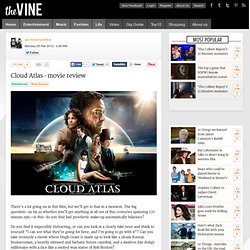
The big question—as far as whether you’ll get anything at all out of this centuries-spanning 170 minute epic—is this: do you find bad prosthetic make-up automatically hilarious? Do you find it impossibly distracting, or can you look at a clearly fake nose and think to yourself “I can see what they’re going for here, and I’m going to go with it”? New film: "Cloud Atlas": Terribly ambitious. Cloud Atlas – review. Dai Congrong's bestselling Chinese translation of James Joyce's Finnegans Wake and the film version of David Mitchell's 2004 Booker shortlisted novel, Cloud Atlas, both complex fictions about the cyclical nature of life, should warn us against calling anything unfilmable or untranslatable.
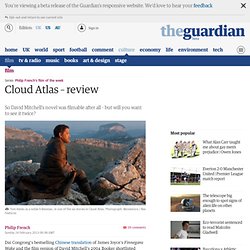
They are not necessarily proof, however, that they're worth filming or translating. In a charming introduction to the new paperback edition of his novel, Mitchell expresses his good fortune that it fell into such "capable hands" as Lana and Andy Wachowski and Tom Tykwer, the film's co-directors and adaptors. The Wachowskis love intricate narratives and the world of ideas; their Matrix trilogy has, I believe, been used in introductory philosophy courses at American colleges. Cloud Atlas review: Bonkers films makes Halle Berry white and Hugh Grant a cannibal. By Chris Tookey Published: 01:50 GMT, 22 February 2013 | Updated: 15:33 GMT, 22 February 2013 Verdict: A super-colossal flop Rating: Turkey Six bad films for the price of one, this vanity mega-flop cost £65 million to make and heaven knows how much to publicise.
